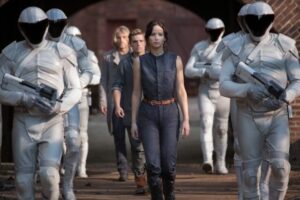HollywoodandFine.com
There’s not much to say about “The Hunger Games: Catching Fire,” because it does what it’s supposed to.
The sequel to last year’s hit, this second installment of what was a trilogy of books (but which will be a quartet of films) is directed by Francis Lawrence (the original was done by Gary Ross) with a script by Simon Beaufoy and Michael DeBruyn (the original was by Billy Ray and the books’ author, Suzanne Collins).
A series of young-adult novels that crossed over to the mainstream almost as vigorously as the Harry Potter books, the “Hunger Games” novels posit a future in which the U.S., now called Panem, has been through a revolution. Since then, power has coalesced in the Capitol under President Snow (an insinuating Donald Sutherland) and the country has been divided into districts.
It’s obviously a fascist state, with the citizens’ concerns and complaints ignored; the Capitol distracts them with an annual spectacle called the Hunger Games, a televised gladiatorial event in which two young people from each district are chosen to battle to the death, until only one emerges alive. But, in the first book/film, a young woman named Katniss Everdeen (Jennifer Lawrence), from the Appalachian-like District 12, figures out a way to not only win but save the young man from her district, Peeta Malark (Josh Hutcherson).
Their love story captivates the audience. But Snow recognizes their dual victory – something Katniss manipulated into happening – for what it is: a form of defiance that could spark a revolt.
That’s where “Hunger Games 2” begins
This review continues on my website.

